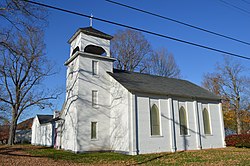Anglican Diocese of Pittsburgh
Diocese of Pittsburgh | |
|---|---|
| Location | |
| Ecclesiastical province | Anglican Church in North America |
| Statistics | |
| Parishes | 70[1] |
| Members | 15,480[2] |
| Information | |
| Rite | Anglican |
| Current leadership | |
| Bishop | The Most Rev. Robert Duncan The Rt. Rev. Frank Lyons (assistant) |
| Website | |
| pitanglican.org | |
The Anglican Diocese of Pittsburgh, formerly known as the Episcopal Diocese of Pittsburgh (Southern Cone), is a diocese of the Anglican Church in North America. It has parishes in the several counties of Western Pennsylvania. In addition, the diocese has oversight of several Anglican parishes that are not located within its geographical boundaries. The diocese has one or more parishes in the US states of Iowa, Kansas, Minnesota, Missouri, North Carolina, Ohio, Tennessee, Texas, Utah, and Wisconsin. Illinois and California are home to over 10 parishes each. The diocese also has a parish in Mexico.[3]
The diocese is home to numerous Episcopal/Anglican organizations including the Church Army, Rock the World Youth Mission Alliance, and the Society of Anglican Missionaries and Senders (formerly South American Missionary Society). Perhaps the most prominent of these is Trinity School for Ministry, a leading evangelical, low church seminary in the Anglican tradition.[4]
The diocese originated from the Episcopal Diocese of Pittsburgh, a diocese of the Episcopal Church. In 2008, the Episcopal Diocese of Pittsburgh split into two bodies when the majority of its parishes left the Episcopal Church to become the Anglican Diocese of Pittsburgh.
History
Episcopal Church origins

The Anglican Diocese of Pittsburgh shares its history prior to 2008 with the Episcopal Diocese of Pittsburgh, which was established in 1865 from the western portion of the Episcopal Diocese of Pennsylvania.[5] Anglicanism in western Pennsylvania began under a priest from Pittsburgh, a Rev. Mr. Taylor, who founded St. Luke's Church at Georgetown in 1814; it remains the diocese's oldest extant parish.[6]
Beginning with the leadership of Bishop Alden Hathaway (1983–1997) and intensifying under his successor, Bishop Robert Duncan, the Episcopal Diocese of Pittsburgh had been a front line in the struggle between theological conservatives and liberals within the Episcopal Church. The theological struggles within the church escalated over the election of Gene Robinson as bishop of the Episcopal Diocese of New Hampshire and the Episcopal Church's first openly gay bishop (see Homosexuality and Anglicanism). Bishop Duncan in particular had taken up a prominent role in the conservative movement within the church.
On November 2, 2007, the convention of the Episcopal Diocese of Pittsburgh voted to amend its constitution and withdraw the diocese from the Episcopal Church. Constitutional changes require votes at two successive annual conventions. In October 2008, a majority of the diocesan convention voted a second time to leave the Episcopal Church and join the Anglican Province of the Southern Cone, a sister province of the Episcopal Church within the Anglican Communion.[7] The Episcopal Diocese of Pittsburgh was the second diocese whose convention voted to leave the Episcopal Church in this fashion, after the Diocese of San Joaquin.
These actions were believed by the Episcopal Church to be ultra vires and null. While the majority of parishes approved of the decision to leave the Episcopal Church, a minority of parishes and members remained in the Episcopal Church and continued to claim that they were the legitimate Episcopal Diocese of Pittsburgh.
Post-realignment history
In 2009, the members of the diocese joined with other Anglican bodies to form the Anglican Church of North America. Bishop Duncan was elected to be the first archbishop and primate of the new church.
Both dioceses claimed to be the successor to the undivided diocese, and they both continued to use the same name until October 2009. At that time the Commonwealth Court ruled that all diocesan property belonged to the Episcopal Diocese of Pittsburgh that was part of the Episcopal Church. In January 2010 the court received a schedule of property including an investment portfolio of over $20 million and the deeds to 49 properties including 22 occupied by congregations participating in the Anglican Church of North America. The Commonwealth Court of Appeals affirmed the award of property February 2011 and refused to reconsider its ruling in March 2011.[8][9]
References
- ^ Diocesan Parish Finder. Accessed December 26, 2013.
- ^ 2013 Diocesan Pre-Convention Journal, Section F: Parochial and Diocesan Statistics, Miscellany, p. F8. Accessed December 26, 2013.
- ^ 2012 Diocesan Pre-Convention Journal, pp. 199-102. Accessed December 26, 2013.
- ^ Mission Partners, Anglican Diocese of Pittsburgh. Accessed December 27, 2013.
- ^ http://www.pitanglican.org/archives/historyofdiocese
- ^ Bonzo, Gertrude. "ST. LUKE'S EPISCOPAL CHURCH". Milestones: The Journal of Beaver County History 7.1 (1982): [pages omitted].
- ^ Schjonberg, Mary Frances (October 4, 2008). "Pittsburgh votes to leave Episcopal Church, align with Southern Cone". Episcopal News Service. Retrieved October 11, 2008.
- ^ See the original appeal ruling at http://www.episcopalpgh.org/docs/commonwealthcourt%20020022011opinion.pdf and the denial of the request for a rehearing http://www.episcopalpgh.org/wp-content/uploads/file/reargument-Denied_03292011.pdf
- ^ "Anglican Diocese of Pittsburgh Responds to Court Ruling". Anglican Diocese of Pittsburgh Press Office, October 29, 2009.
